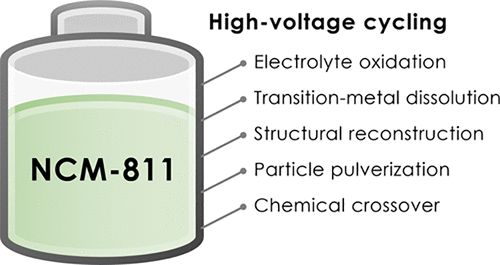当前位置:
X-MOL 学术
›
Chem. Mater.
›
论文详情
Our official English website, www.x-mol.net, welcomes your
feedback! (Note: you will need to create a separate account there.)
Long-Term Cyclability of NCM-811 at High Voltages in Lithium-Ion Batteries: an In-Depth Diagnostic Study
Chemistry of Materials ( IF 7.2 ) Pub Date : 2020-08-27 , DOI: 10.1021/acs.chemmater.0c02398 Wangda Li 1 , Xiaoming Liu 2 , Qiang Xie 1 , Ya You 1 , Miaofang Chi 2 , Arumugam Manthiram 1
Chemistry of Materials ( IF 7.2 ) Pub Date : 2020-08-27 , DOI: 10.1021/acs.chemmater.0c02398 Wangda Li 1 , Xiaoming Liu 2 , Qiang Xie 1 , Ya You 1 , Miaofang Chi 2 , Arumugam Manthiram 1
Affiliation

|
High-nickel layered oxides, such as LiNi0.8Co0.1Mn0.1O2 (NCM-811), offer higher energy density than their low-nickel counterparts at a given voltage and are gaining major traction in automotive lithium-ion batteries for electric vehicles. Besides high-Ni content, higher charging voltages above 4.3 V vs Li+/Li boost the energy and represent another focus in battery development. Here, we investigate the long-term cyclability of NCM-811 in graphite pouch cells over 1000 deep cycles between 2.5–4.2, 2.5–4.4, and 2.5–4.5 V through a suite of sensitive characterization techniques. The NCM-811 full cells show severely deteriorated cyclability with higher charging voltages, from 78% at 4.2 V to 52 and 32% at 4.4 and 4.5 V, respectively. At 4.2 V, minor parasitic electrolyte oxidation as well as cathode Li/Ni mixing and cracking are revealed after cycling, while transition-metal dissolution and surface reconstruction into rock-salt NiO are virtually undetectable. At 4.4 and 4.5 V, transition-metal dissolution and crossover to the anode become much more pronounced and a primary contributor to the capacity fade, while significant surface NiO formation causes substantial voltage polarization, which is less noticeable at 4.2 V. Meanwhile, more severe electrolyte oxidation, Li/Ni mixing, and particle pulverization exacerbate the voltage and capacity fade. These results outline distinct challenges for stable high-Ni layered oxide cathodes in high-voltage Li-ion batteries.
中文翻译:

NCM-811在锂离子电池高电压下的长期循环性:深度诊断研究
在给定电压下,高镍层状氧化物(例如LiNi 0.8 Co 0.1 Mn 0.1 O 2(NCM-811))比低镍层状氧化物具有更高的能量密度,并在电动汽车用锂离子电池中获得了广泛的关注。除了高镍含量外,相对于Li +,更高的充电电压高于4.3 V/ Li增强了能量,并代表了电池开发的另一个重点。在这里,我们通过一套敏感的表征技术研究了NCM-811在石墨袋电池中2.5至4.2、2.5至4.4和2.5至4.5 V的1000个深循环中的长期可循环性。NCM-811充满电的电池在较高的充电电压下显示出严重的可循环性,从4.2 V的78%降至4.4和4.5 V的52%和32%。在循环电压为4.2 V时,显示出微小的寄生电解质氧化以及阴极Li / Ni混合和破裂,而实际上检测不到过渡金属溶解和表面重建为盐岩NiO的现象。在4.4和4.5 V时,过渡金属的溶解和与阳极的交叉变得更加明显,并且是容量衰减的主要因素,虽然大量的表面NiO形成会引起相当大的电压极化,但在4.2 V时很少出现。极化同时,更严重的电解质氧化,Li / Ni混合和颗粒粉碎会加剧电压和容量衰减。这些结果概述了在高压锂离子电池中稳定高镍层状氧化物阴极所面临的独特挑战。
更新日期:2020-09-22
中文翻译:

NCM-811在锂离子电池高电压下的长期循环性:深度诊断研究
在给定电压下,高镍层状氧化物(例如LiNi 0.8 Co 0.1 Mn 0.1 O 2(NCM-811))比低镍层状氧化物具有更高的能量密度,并在电动汽车用锂离子电池中获得了广泛的关注。除了高镍含量外,相对于Li +,更高的充电电压高于4.3 V/ Li增强了能量,并代表了电池开发的另一个重点。在这里,我们通过一套敏感的表征技术研究了NCM-811在石墨袋电池中2.5至4.2、2.5至4.4和2.5至4.5 V的1000个深循环中的长期可循环性。NCM-811充满电的电池在较高的充电电压下显示出严重的可循环性,从4.2 V的78%降至4.4和4.5 V的52%和32%。在循环电压为4.2 V时,显示出微小的寄生电解质氧化以及阴极Li / Ni混合和破裂,而实际上检测不到过渡金属溶解和表面重建为盐岩NiO的现象。在4.4和4.5 V时,过渡金属的溶解和与阳极的交叉变得更加明显,并且是容量衰减的主要因素,虽然大量的表面NiO形成会引起相当大的电压极化,但在4.2 V时很少出现。极化同时,更严重的电解质氧化,Li / Ni混合和颗粒粉碎会加剧电压和容量衰减。这些结果概述了在高压锂离子电池中稳定高镍层状氧化物阴极所面临的独特挑战。











































 京公网安备 11010802027423号
京公网安备 11010802027423号